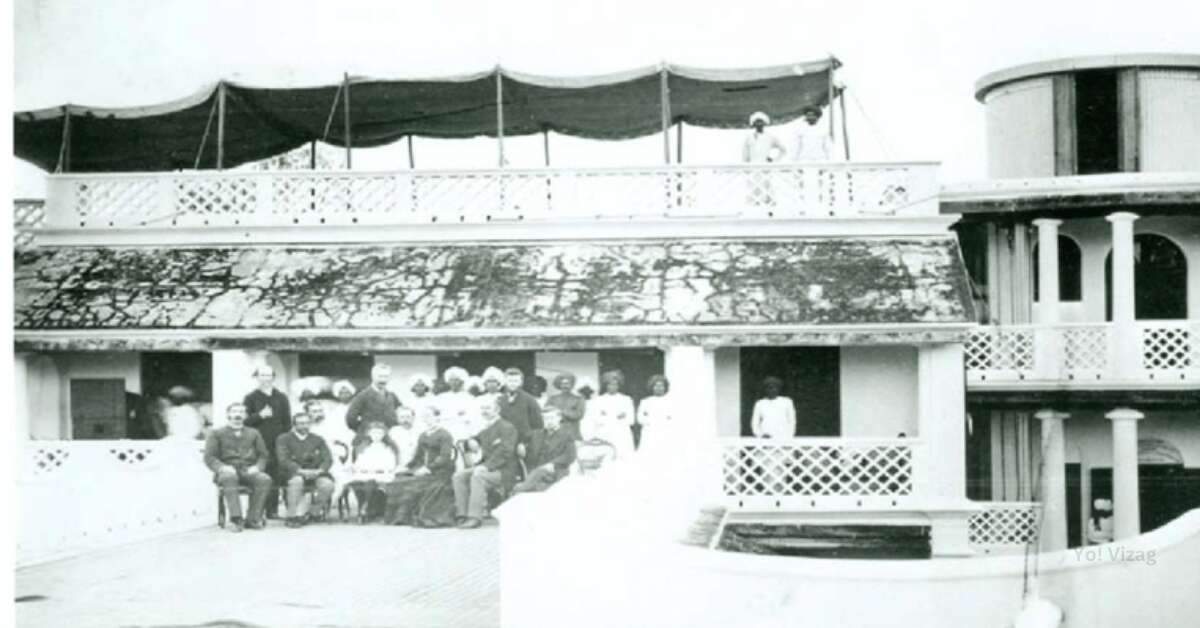

Today, India is celebrating its maiden National Space Day, marking the country’s achievements in space exploration! With the Chandrayaan-3 landing, India has certainly made huge strides in the field. As we applaud today’s triumph, we can’t help but also appreciate the breakthroughs of the past that helped us get here. Visakhapatnam, in particular, has had its moment in the spotlight when it comes to space discoveries, and it is all thanks to the legacy left by a family, who, for generations worked passionately to decode the skies. Their lifelong work once stood in the form of one Jugga Rao Observatory.
According to Visakhapatnam history enthusiast, John Castellas, Jugga Rao Observatory was birthed by eminent Vizag citizen and astronomer, Gode Venkata Jagga Raw (1819-1856), who was one of the early pioneers of observational astronomy in India. After receiving his education in Madras under the renowned astronomer Thomas Glanville Taylor, he returned to Vizagapatnam, where he built the observatory in his own backyard in Dabagardens in 1841.
His legacy was continued by his son-in-law Ankitam Venkata Nursing Row (1827-1892) till 1892, his daughter till 1894, Madras Government till 1898, and his grandson A V Jugga Row till it became inactive in the early 1900s.
While it was operational, observations of comets, planetary transits, stellar occultation etc., were made here along with meteorological observations. Celestial photography was also started at the observatory. All these findings make the Jugga Rao Observatory an early contributor to Indian astronomy and space studies.
Inferring from A V Nursing Row’s publications in Monthly Notes Royal Astronomical Society, here are 6 remarkable contributions made by Jugga Rao Observatory in Visakhapatnam in the 1800s:
One of the notable observations at the Jagga Rao Observatory was the famous solar eclipse of August 16, 1868, which was partial at Vizagapatam.
His detailed observations were documented in a pamphlet, which highlighted the observatory’s capabilities, including the use of a homemade telescope with a 4.8-inch aperture lens procured by G V Jagga Row previously. Although clouds obstructed some of the observations, Rao’s efforts demonstrated the observatory’s advanced techniques, such as using vernier circles, levels, and slow-motion screw movements for precise measurements. In the pamphlet, he also described the Indian method (panchang) of calculations that were applied to the eclipse at Vizagapatam and mythological stories about the eclipses.
(Source: Early Pioneers of Telescopic Astronomy in India: G V Juggarow and His Observatory by N. Kameswara Rao, A. Vagiswari, and Christina Birdie).
A V Nursing Row also made significant observations of the Great September Comet of 1882. His detailed descriptions of the comet, published in the Monthly Notices of the Royal Astronomical Society (MNRAS), provided valuable data on the comet’s position and movement, showcasing the observatory’s contributions to global astronomy. He meticulously recorded the comet’s changing appearance and its tail’s extension, which spanned more than 12 degrees, resembling an elephant’s tusk (Source: Indian Observations of the Great Comet of 1882 by R. C. Kapoor).
Narsinga Rao wrote the following about the Great September Comet, in his communication to MNRAS, dated 8 October 1882:
“A comet is now visible in the eastern heavens before sunrise, and is so conspicuous to the naked eye as to attract general attention. It presents a bright planetary disk, surrounded by nebulosity. On applying higher magnifiers this appearance vanishes, the centre of the head not being occupied by a star-like point. The head has a border of light surrounding it on the side towards the Sun, and continued round on each side of the tail. The disk has been undergoing changes of form and apparent diameter for twelve days. The length of the bright part of the tail is between 7° and 8°, above which are narrow rays or streaks of light extending more than 12° – concave towards the south, and shaped like the tusk of an elephant, the thick part being at the greatest altitude. Observing the comet with the naked eye at the seaside the whole tail took nearly an hour to rise.”
(Source: Indian Observations of the Great Comet of 1882 by R. C. Kapoor).
The observatory also made important observations of the transits of Mercury and Venus. Narsinga Rao observed the transit of Mercury across the Sun’s disc on November 5, 1868, using the 4.8-inch telescope. His detailed records, published in MNRAS, highlighted the significance of these observations in determining the Earth-Sun distance (the astronomical unit).
‘The planet was seen as an intensely dark spot on the Sun’s disk’. He shows a diagram illustrating the path of the transit across the disc and gives the timings of the chord. He seems to have observed a curious phenomenon ‘when the planet approached half-way of the transit, some of my European friends and myself observed a wavy tint of light darting from the upper edge, disturbed at times, but continued until the planet had passed some distance from the highest point of the line of transit’.
Other transits of Mercury observed were dated 8 November 1881 and 10 May 1891.
(Source: Early Pioneers of Telescopic Astronomy in India: G. V. Juggarow and His Observatory by N. Kameswara Rao, A. Vagiswari, and Christina Birdie).
During the transit of Venus on December 9, 1874, Narsinga Rao observed the event with a 6-inch clock-driven equatorial telescope. Due to clouds and limited visibility, he observed only the egress phase. (Source: Indian Observations of the Great Comet of 1882 by R. C. Kapoor).
This transit was notable not only for its scientific significance but also because it was the first one ever to be photographed. Charles Burton, who traveled from Dublin to Rodrigues Island in the Indian Ocean, took these historic photographs as part of an expedition organized by the Royal Observatory in Greenwich.
Sir George Biddell Airy (1801–1892), who served as the Astronomer Royal from 1835 to 1881, began preparations to observe the 1874 transit 17 years before it occurred. Italian astronomer Pietro Tacchini (1838–1905) led an expedition to Muddapur, India.
In the March 1884 issue of Monthly Notices of the Royal Astronomical Society (Volume 44, Issue 5), A.V. Nursing Row published his observations on Comet Pons-Brooks, which were made from Jugga Rao Observatory in Vizagapatnam (now Visakhapatnam). The report stated:
“A comet was in our western sky on the 15th instant, suffi-ciently conspicuous to the naked eye to attract general attention. I believe it is the same comet that was found in September 1883 by Mr Brooks in the United States.”
He further said that the observation was made on the 29th of the month, at a sidereal time of 3 hours 58 minutes and 4 seconds. The comet’s approximate Right Ascension was recorded as 0 hours 23 minutes 43 seconds, and its Declination as 24 degrees 5 minutes.
The G V Juggarao Observatory was likely the first in India to systematically capture photographic observations of the night sky. Various clusters and nebulae were photographed using a small photographic telescope, with one of the best images being of the region near 71 Argus (now known as q Carinae).
Professor H H Turner provided assistance and advice in selecting different types of photographic plates for testing at the observatory. A sidereal-time watch was also ordered specifically for the observatory’s photographic needs. The camera and chronometer were generously arranged by Michie Smith, the Government Astronomer at Madras, but they had not arrived by the end of the year.
(Source: Early Pioneers of Telescopic Astronomy in India: G.V. Juggarow and His Observatory by N Kameswara Rao, A. Vagiswari, & Christina Birdie)
G V Jagga Row’s passion for astronomy led to the establishment of this pioneering observatory in Vizag. Even after his death, the legacy continued, and even flourished with A V Nursing Row, who maintained the observatory and made notable contributions to both astronomy and meteorology. Their work ensured that Vizag had a vital place in the history of astronomy.
The observatory was also meaningful to Vizag, as it was here that the city’s latitudes and longitudes were established. Moreover, the observatory also took on the responsibility of setting up a flagstaff on Dolphin’s Nose, where time-gun firing was organised to provide time signals to the public. Nursing Row donated a sum of Rs 1,15,000 as an endowment to the then-Hindu College when it was in financial difficulties.
It’s fair to say that at a time when astronomy was under the grip of British in India, the Jugga Rao Observatory in Visakhapatnam played a strong part in India’s space ventures. Given its association with Vizag, an interesting question comes to mind: as new constellations and stars are continually being discovered, should campaign to have a new constellation named “Visakha” and a star named after Rajah Jagga Rao?
Read also: Riddle of the Jagga Rao Observatory in Vizag
Stay tuned to Yo! Vizag website and Instagram for more such stories.
Entertainment comes in many forms. It might be in the form of a thrilling video…
Whether you're an early bird or an early grump, it goes without saying that the…
As of today, IndiGo has opened bookings for a brand-new daily flight service connecting Visakhapatnam…
Visakhapatnam is preparing for one of its most spiritually charged and widely attended events, the…
Andhra University (AU) Vice-Chancellor G P Raja Sekhar has issued orders to relieve aided college…
In light of President Droupadi Murmu's scheduled visit to Vizag on 10 June 2025 to…
Leave a Comment